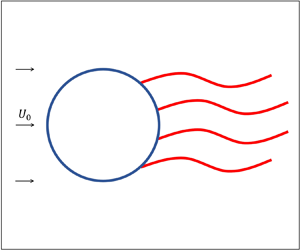Crossref Citations
This article has been cited by the following publications. This list is generated based on data provided by
Crossref.
Heyat Davoudian, Salar
and
Javadi, Khodayar
2022.
Flexible polymeric tail for micro robot drag reduction bioinspired by the nature microorganisms.
Physics of Fluids,
Vol. 34,
Issue. 11,
Zhang, Huanyu
Zhao, Yakun
Tian, Xinliang
and
Liu, Hao
2023.
Effects of the closed domain area on the dynamics of a closed flexible filament behind a rigid plate.
Ocean Engineering,
Vol. 288,
Issue. ,
p.
115944.
Zhang, Huanyu
Zhao, Yakun
Tian, Xinliang
Wang, Xiaolong
and
Liu, Hao
2023.
Symmetry breaking of a closed flexible filament behind a rigid plate at low Reynolds numbers.
Physics of Fluids,
Vol. 35,
Issue. 2,
Shukla, Sarvesh
Sharma, Atul
Agrawal, Amit
and
Bhardwaj, Rajneesh
2024.
Fish-Inspired Oscillating and/or Undulating Hydrofoil in a Free Stream Flow: A Review on Thrust Generation Mechanisms.
Journal of the Indian Institute of Science,
Vol. 104,
Issue. 1,
p.
147.
Liu, Zhiwei
Wang, Hanfeng
Li, Jiaxuan
Li, Huan
and
Zhao, Chongyu
2024.
Flapping dynamics of a flexible membrane attached to the leading edge of a forward-facing step.
Physics of Fluids,
Vol. 36,
Issue. 5,
Muñoz-Hervás, J.C.
Lorite-Díez, M.
García-Baena, C.
and
Jiménez-González, J.I.
2024.
Experimental investigation of rear flexible flaps interacting with the wake dynamics behind a squareback Ahmed body.
Journal of Fluids and Structures,
Vol. 127,
Issue. ,
p.
104124.
Li, Botong
Zhao, Zitian
Meng, Linyu
and
Zhu, Liangliang
2024.
On the fluid drag reduction in scallop surface.
The European Physical Journal E,
Vol. 47,
Issue. 6,
Chen, Lu
Liu, Shao-gang
Zhao, Dan
Dong, Li-qiang
Li, Kai
Tang, Shuai
Cui, Jin
and
Guo, Hong
2024.
Research on the flow stability and noise reduction characteristics of quasi-periodic elastic support skin.
Defence Technology,
Vol. 33,
Issue. ,
p.
222.
Zhang, Huanyu
Zhao, Yakun
Tian, Xinliang
and
Liu, Hao
2024.
Numerical simulations of the flow past a perforated plate enclosed by a filament using the Immersed Boundary Method.
Ocean Engineering,
Vol. 304,
Issue. ,
p.
117860.
Yin, Dawei
and
Sun, Jinjing
2025.
Enhancing vertical-axis tidal turbines with strategic superhydrophobic surfaces for optimized aerodynamic and self-starting performances.
Ocean Engineering,
Vol. 324,
Issue. ,
p.
120698.
Afrouzi, Hamid Hassanzadeh
Shiri, Saeid
Hasani, MohammadAmir
Seyyedi, Seyyed Mostafa
Salahshour, Soheil
Abouei Mehrizi, Abbasali
Chen, Xiaohu
and
Pashaie, Pouya
2025.
Exploring the role of filaments in channel flow modification using the immersed boundary lattice Boltzmann method.
Flow Measurement and Instrumentation,
Vol. 106,
Issue. ,
p.
102952.
Zhang, Huanyu
Zhao, Yakun
Wang, Peng
Wen, Binrong
Tian, Xinliang
and
Liu, Hao
2025.
Numerical simulations on the flow past a flexible filament with two fixed ends at a low Reynolds number.
Journal of Fluid Mechanics,
Vol. 1009,
Issue. ,
Choi, Seungho
Lee, Minhyeong
Roh, Chris
and
Kim, Daegyoum
2025.
Freely falling sphere with a rigid rear-side filament.
Journal of Fluid Mechanics,
Vol. 1010,
Issue. ,
Lu, Shan
Liu, Jianbo
Li, Hang
Qin, Liguo
Wang, Zheng
Wu, Yuhao
Ma, Zeyu
and
Hu, Qiao
2025.
Experimental and simulation study of bio-inspired adaptive transverse wave microgrooves for underwater drag reduction.
Tribology International,
Vol. 205,
Issue. ,
p.
110564.
Zhao, Yakun
Zhang, Huanyu
Sun, Shuyue
Peng, Tao
Chen, Gang
and
Tian, Xinliang
2025.
A wind tunnel experimental investigation for the flow normal to a flat plate attached with a closed membrane coating.
European Journal of Mechanics - B/Fluids,
Vol. 111,
Issue. ,
p.
127.
